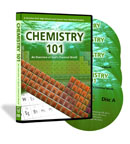Chemistry 101 is a high school chemistry course presented through videos that makes the subject far more interesting than textbook-only courses. The course is available either streamed or on a set of four DVDs.
Wes Olson teaches the course, explaining and demonstrating each topic. He teaches through storytelling much of the time, using live film footage, graphic animations, demonstrations, and other methods of visual presentation. Through the storytelling, Olson teaches much more of the history of chemistry than students usually learn. He also spends more time on each of the elements on the periodic table, explaining interesting tidbits and practical applications for most of them.
The course is divided into four main sections: “The Road to the Periodic Table,” “Chemistry Essentials,” “Meet the Elements,” and “The Future of Chemistry.” The Chemistry Essentials section is where we find content that is most similar to that of other high school chemistry courses: information on atoms, neutrons, isotopes, molecules, compounds, and chemical equations. However, while Olson explains chemical bonds and chemical equations, these topics are given relatively brief attention compared to other high school texts. For example, Olson explains how to balance chemical equations, but students never have to write an equation, much less balance one.
The course includes two essential PDF files that you will almost certainly want to print out: The Guidebook and the Accreditation Booklet. The 120-page Guidebook serves as the textbook. It repeats the information presented on the videos with occasional additional comments. The Guidebook includes a few discussion questions for each section plus a ten-question multiple-choice quiz.
The Accreditation Booklet for parents has lesson plans for the course that include mini-labs. Lesson plan charts show how much time is likely to be spent on each activity to comprise a course that should take about 150 hours. However, the lesson plans direct students to watch each video lesson twice and read each lesson twice, something I suspect won’t happen on a regular basis. So it might be difficult to accumulate 150 hours of work.
Lab activities are relatively simple, often using household items. However, since you still need a few unusual items like a nine-volt battery, dry ice, and a magnesium fire starter, a list of items required for each activity is included in a chart on page four. Lab activities are typical of what you might see in programs for younger students. While they are fun and informative, they do not involve the use of actual lab equipment, measurement, data collection, and other learning experiences typical of a high school lab course. Many of the lab activities are demonstrated on the video so students know in advance what to expect. Consequently, lab activities are not very challenging. However, students will create a lab notebook where they will write 200-word reports on each activity.
In addition to the mini-labs, the lesson plans require students to occasionally complete additional research and write summaries or reports. However, reports are generally described as being only 50-200 words in length which amounts to only one or two paragraphs.
I really like Olson’s presentation and teaching style in this course, and it serves well as an introduction to chemistry. While it might serve students who are not college bound to meet a very minimal lab science requirement, it needs “beefing up” for students heading to college. The free “Basics Concepts in Chemistry” material at https://www.shodor.org/unchem/basic/, particularly the sections on chemical reactions, stoichiometry, and acid-base chemistry, might provide additional study material. (This is the sort of information that is particularly lacking in Chemistry 101.) You might also use something like the Thames and Kosmos Chem C2000 or Chem C3000 experiment kits for more serious lab work and explanations of experiments.
Chemistry 101 is subtitled, An Overview of God’s Chemical World, reflecting the Christian worldview that Olson presents throughout the course. Olson handles this part very well, not coming off as preachy, yet making connections that help students to either see God’s hand in creation or consider how chemistry might be used to advance or hinder righteousness.
While the course is intended for high school level, because it lacks some of the content expected of most high school courses, you might also consider using it with eighth graders instead. It will provide an excellent foundation for future chemistry studies and likely instill in students an interest in chemistry. If you choose to use it at high school level for college-bound students, be sure to expand the course to ensure that students are adequately prepared.








